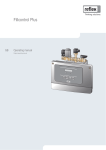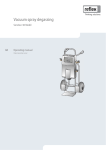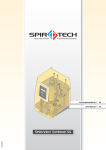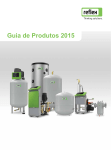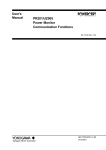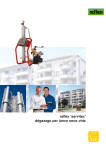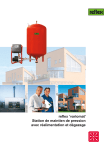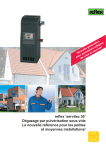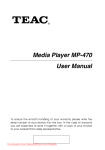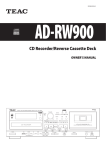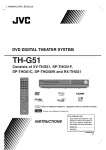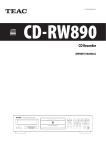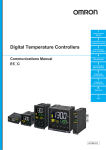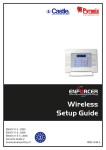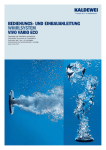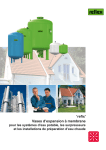Download Variomat with Touch controller
Transcript
Variomat with Touch controller with one pump: VS 2-1/60 /75 /95 with two pumps: VS 2-2/35 /60 /75 /95 GB Operating manual Original operating manual 25.06.2014 Contents English Variomat with Touch controller 25.06.2014 Contents 1 Notes on the operating manual .................................................................................................................................................... 5 2 Liability and guarantee .................................................................................................................................................................. 5 3 Safety ............................................................................................................................................................................................... 6 3.1 3.2 3.3 3.4 3.5 3.6 4 Explanation of symbols ........................................................................................................................................................................ 6 3.1.1 Symbols and notes used................................................................................................................................................... 6 3.1.2 Safety symbols used.......................................................................................................................................................... 6 Personnel requirements ...................................................................................................................................................................... 7 Personal protective equipment .......................................................................................................................................................... 7 Intended use .......................................................................................................................................................................................... 7 Inadmissible operating conditions..................................................................................................................................................... 7 Residual risks ......................................................................................................................................................................................... 8 Description of the device ............................................................................................................................................................... 9 4.1 4.2 4.3 4.4 4.5 4.6 Description ............................................................................................................................................................................................. 9 Overview ................................................................................................................................................................................................ 9 Identification ....................................................................................................................................................................................... 10 4.3.1 Nameplate ........................................................................................................................................................................ 10 4.3.2 Type code.......................................................................................................................................................................... 10 Function ............................................................................................................................................................................................... 11 Scope of delivery ................................................................................................................................................................................. 13 Optional equipment and accessories .............................................................................................................................................. 13 5 Technical data ...............................................................................................................................................................................14 6 Installation .....................................................................................................................................................................................17 6.1 6.2 6.3 6.4 6.5 6.6 7 Installation conditions ....................................................................................................................................................................... 18 6.1.1 Incoming inspection ....................................................................................................................................................... 18 Preparatory work ................................................................................................................................................................................ 18 Execution.............................................................................................................................................................................................. 19 6.3.1 Positioning ....................................................................................................................................................................... 19 6.3.2 Installation of add-on components for the tanks ....................................................................................................... 20 6.3.3 Tank installation .............................................................................................................................................................. 21 6.3.4 Hydraulic connection ...................................................................................................................................................... 23 6.3.5 Fitting the thermal insulation ....................................................................................................................................... 26 6.3.6 Fitting the level sensor ................................................................................................................................................... 27 Switching and make-up variants...................................................................................................................................................... 28 6.4.1 Function ............................................................................................................................................................................ 28 Electrical connection .......................................................................................................................................................................... 31 6.5.1 Terminal plan, connection component........................................................................................................................ 32 6.5.2 Terminal plan, operating unit........................................................................................................................................ 34 6.5.3 RS-485 interface .............................................................................................................................................................. 35 Installation and commissioning certificate ..................................................................................................................................... 36 Commissioning .............................................................................................................................................................................37 7.1 7.2 7.3 7.4 7.5 7.6 Checking the requirements for commissioning ............................................................................................................................. 37 Determining the P0 minimum operating pressure for the controller ......................................................................................... 38 Modifying the controller's start routine .......................................................................................................................................... 39 Filling the tanks with water............................................................................................................................................................... 39 7.4.1 Filling with a hose ........................................................................................................................................................... 39 7.4.2 Filling with the solenoid valve in the make-up .......................................................................................................... 39 Venting the pump............................................................................................................................................................................... 40 Parametrising the controller in the Customer menu .................................................................................................................... 41 Variomat with Touch controller — 25.06.2014 English — 3 Contents 7.7 8 Operation ...................................................................................................................................................................................... 42 8.1 8.2 9 Operating modes ................................................................................................................................................................................ 42 8.1.1 Automatic mode .............................................................................................................................................................. 42 8.1.2 Manual mode ................................................................................................................................................................... 43 8.1.3 Stop mode ........................................................................................................................................................................ 44 8.1.4 Summer operation .......................................................................................................................................................... 44 Restarting ............................................................................................................................................................................................. 44 Controller ...................................................................................................................................................................................... 45 9.1 9.2 9.3 9.4 9.5 10 Starting Automatic mode .................................................................................................................................................................. 41 Operator panel .................................................................................................................................................................................... 45 Calibrating the touch screen ............................................................................................................................................................. 46 Modifying the controller's start routine .......................................................................................................................................... 47 Configuring settings in the controller ............................................................................................................................................. 50 9.4.1 Customer menu ............................................................................................................................................................... 50 9.4.2 Service menu.................................................................................................................................................................... 53 9.4.3 Default settings ............................................................................................................................................................... 54 9.4.4 Setting degassing programmes .................................................................................................................................... 56 9.4.5 Degassing programmes – overview ............................................................................................................................. 58 Messages .............................................................................................................................................................................................. 59 Maintenance ................................................................................................................................................................................. 62 10.1 10.2 10.3 10.4 10.5 Maintenance schedule ....................................................................................................................................................................... 63 Cleaning ............................................................................................................................................................................................... 64 10.2.1 Cleaning the dirt trap...................................................................................................................................................... 64 10.2.2 Cleaning the tanks .......................................................................................................................................................... 65 Checking switching points ................................................................................................................................................................ 66 Maintenance certificate ..................................................................................................................................................................... 68 Inspection ............................................................................................................................................................................................ 69 10.5.1 Pressure-bearing components ...................................................................................................................................... 69 10.5.2 Inspection prior to commissioning ............................................................................................................................... 69 10.5.3 Inspection intervals ......................................................................................................................................................... 69 11 Disassembly .................................................................................................................................................................................. 70 12 Annex ............................................................................................................................................................................................ 71 12.1 12.2 12.3 12.4 12.5 4 — English Reflex Customer Service .................................................................................................................................................................... 71 Conformity and standards ................................................................................................................................................................. 72 Certificate No. of the design type examination ............................................................................................................................. 74 Guarantee ............................................................................................................................................................................................ 74 Glossary ................................................................................................................................................................................................ 74 Variomat with Touch controller — 25.06.2014 Notes on the operating manual 1 Notes on the operating manual This operating manual is an important aid for the safe and reliable function of the device. The operating manual is intended to: • Avert dangers to personnel. • Understand the device. • Obtain optimal functioning. • Early identify and rectify problems. • Avoid faults caused by improper use. • Prevent repair costs and downtimes. • Increase reliability and service life. • Prevent damage to the environment. Reflex Winkelmann GmbH cannot accept any liability for damage caused by ignoring this operating manual. In addition to this operating manual, you must comply with national legislation and regulations in the country of use (accident prevention, environment protection, save and proper work, etc.). This operating manual describes the device with basic equipment and interfaces for optional equipment with additional functions. For optional equipment and accessories, see chapter 4.6 "Optional equipment and accessories" on page 13 . Notice! Every person installing this equipment or performing any other work at the equipment is required to carefully read this operating manual prior to commencing work and to comply with its instructions. The manual is to be provided to the device operator and must be stored near the device for access at any time. 2 Liability and guarantee The product is manufactured to the latest engineering standards and acknowledged safety regulations. Nevertheless, risk of injury and death for the user and other parties and damage to the system and other property can arise from its use. Modifications of the device such as changes of the hydraulic system or interference with the interconnection are strictly prohibited. The liability and guarantee of the manufacturer are excluded when the malfunction can be traced back to one or more of the following causes: • Improper use of the device. • Improper commissioning, operation, maintenance, servicing, repair, and installation of the device. • Ignoring the safety notes in this operating manual. • Device operation with defective or improperly installed safety and/or protective equipment. • Failure to perform maintenance and inspection work at due times. • Use of unauthorised replacement parts and accessories. The precondition for any guarantee claims is the proper installation and commissioning of the device. Notice! Have the Reflex Customer Service carry out commissioning and the annual maintenance, see chapter 12.1 "Reflex Customer Service" on page 71 . Variomat with Touch controller — 25.06.2014 English — 5 Safety 3 Safety 3.1 Explanation of symbols 3.1.1 Symbols and notes used The following symbols are used in this operating manual. Danger • Danger to life and/or severe damage to health – The corresponding warning symbol in combination with the "Danger" signal term indicates an imminent threatening danger which will result in death or severe (irreversible) injuries. Warning • Severe damage to health – The corresponding warning symbol in combination with the "Warning" signal term indicates a threatening danger which may result in death or severe (irreversible) injuries. Caution • Damage to health – The corresponding warning symbol in combination with the "Caution" signal term indicates a danger which may result in minor (reversible) injuries. Attention! • Damage to property – This symbol in combination with the "Attention" signal word indicates a situation that may cause damage to the product itself or objects in its vicinity. Notice! This symbol in combination with the "Notice" signal word indicates useful tips and recommendations regarding the efficient use of the product. 3.1.2 Safety symbols used The following safety symbols are used in this operating manual. They are also attached to the equipment or in its vicinity. This symbol warns of electric.voltage. This symbol warns of a hot surface. This symbol warns of overpressure in conduits and connections. 6 — English Variomat with Touch controller — 25.06.2014 Safety 3.2 Personnel requirements Only specialist personnel or specifically trained personnel may install and operate the equipment. The electric connections and the wiring of the device must be executed by a specialist in accordance with all applicable national and local regulations. 3.3 Personal protective equipment When working at the system, wear the stipulated personal equipment such as hearing and eye protection, safety boots, helmet, protective clothing, protective gloves. See the national regulation of your country for personal protective equipment required. 3.4 • • 3.5 Intended use The devices are manufactured from steel with exterior coating; the interior is uncoated. The devices may be used only in systems that are sealed against corrosion and with the following water types: • Non-corrosive • Chemically non-aggressive • Non-toxic The ingress of atmospheric oxygen by permeation into the entire heating and cooling water system, make-up water and similar must be reliably minimised during operation. Inadmissible operating conditions The devices are not suited for the following conditions. • In mobile system operation • For outdoors operation • For the use with mineral oils • For the use with flammable media • For the use with distilled water Notice! Changes to the hydraulic system or interference with the interconnection are strictly prohibited. Variomat with Touch controller — 25.06.2014 English — 7 Safety 3.6 Residual risks This device has been manufactured to the current state of the art. However, some residual risk cannot be excluded. Caution – risk of burning! • Excessive surface temperatures in heating systems can cause skin to burn. – Wait until surfaces have cooled down or wear protective gloves. – The operator is required to attach corresponding warning notes in the device vicinity. Caution – risk of injury! • Incorrect installation or service work may cause burns and other injuries at the connections when hot water or steam suddenly escape at pressure. – Ensure proper installation. – Ensure that the system is de-pressurised before performing service work at the connections. Warning – large weight! • 8 — English The devices are very heavy. Thus, there is a risk of physical damage and accidents. – Use only lifting gear suitable for transport and installation. Variomat with Touch controller — 25.06.2014 Description of the device 4 Description of the device 4.1 Description The Variomat is a pump-controlled pressure maintaining, make-up and degassing station for heating and cooling water systems. The Variomat is essentially a controller with pump and at least one expansion tank. A diaphragm in the extension tank separates the same into an air and a water space, preventing the penetration of atmospheric oxygen into the expansion water. The Variomat provides the following safety features: • Optimisation of all pressure maintaining, degassing and make-up processes. • No direct intake of air thanks to a regulation of the pressure maintenance with automatic make-up. • No circulation issues caused by free bubbles in the circuit water. • Reduced corrosion damage due to oxygen removal from fill and make-up water. 4.2 Overview Variomat with touch control and two pumps Variomat with touch control and one pump 1 Main switch 5 "VF" secondary tank 2 6 "VG" primary tank 3 Control unit • Pump(s) • "Reflex Control Touch" controller "VE" equalisation elbow 7 "FD" feed and drain cock 4 "DV" degassing valve 8 "LIS" level sensor Variomat with Touch controller — 25.06.2014 English — 9 Description of the device 4.3 Identification 4.3.1 Nameplate The nameplate provides manufacturer information, year of manufacture, serial number, and technical data. Information on nameplate Type Serial No. min. / max. allowable pressure P Meaning Device name Serial number Minimum/maximum permissible pressure max. continuous operating Maximum temperature for temperature continuous operation min. / max. allowable Minimum/maximum temperature / flow temperature permissible TS temperature/TS flow temperature Year built Year of manufacture min. operating pressure set up on Factory-set minimum shop floor operating pressure at site Set minimum operating pressure max. pressure saftey valve Factory-set opening factory - aline pressure of the safety valve at site Set opening pressure of the safety valve 4.3.2 Type code No. 1 2 3 4 5 6 Control unit designation Number of pumps Pump type Primary tank Nominal volume Secondary tank Type code 10 — English Variomat VS 2-1/60, VG 500 l, VF 500 l 1 2 3 4 5 6 Variomat with Touch controller — 25.06.2014 Description of the device 4.4 1 2 3 Function 6 Heating system "MAG" pressure expansion tank Reflex Fillset Impulse, see chapter 4.6 "Optional equipment and accessories" on page 13 . Control unit Hydraulic inlets • For gas-rich water • For degassed water Primary tank air space 7 ST FQIRA+ WC Secondary tank air space Dirt trap Contact water meter Make-up line 4 5 WV PIS PV Make-up valve Pressure sensor Overflow valve (motor ball valve) PU SV Pump (pressure maintenance) Safety valve EC Expansion line • For gas-rich water • For degassed water Feed and drain cock Pressure pick-up Degassing valve Aeration and de-aeration FD LIS DV VE The device is a pressure maintaining station for heating and cooling water systems. It is used for maintaining pressure, making-up and degassing the water in heating and cooling systems. It comprises a control unit consisting of a controller with hydraulics and at least one expansion tank. Expansion tank One primary tank and multiple optional secondary tanks may be connected. A diaphragm separates the tanks into an air and a water space, preventing the penetration of atmospheric oxygen into the expansion water. The "VE" line connects the air space with the atmosphere. The primary tank is hydraulically flexibly connected to the control unit. The function of the "LIS" level measuring using a pressure pick-up is thus ensured. Variomat with Touch controller — 25.06.2014 English — 11 Description of the device Control unit The control unit contains the hydraulic system and the controller. The "PIS" pressure transducer records the pressure and the "LIS" pressure pick-up registers the level; both values are displayed at the controller. Maintaining pressure The pressure in the system rises when the water is heated. When the pressure set at the controller is exceeded, the "PV" overflow valve opens and drains water from the system into the primary tank, using the "EC" expansion line. The pressure within the system drops. The pressure in the system drops when the water cools. When the pressure drops below the set value, the "PU" pump is activated and uses the "EC" expansion line to transport water from the primary tank back into the system. The pressure in the system rises. The controller ensures that the pressure is maintained, further supported by the stabilisation provided by the "MAG" expansion tank. Degassing Two "EC" expansion lines are required to degas the system water. One line is intended for gas-rich water from the system, and the other one serves to return the degassed water to the system. During the degassing action, the "PU" pump and the "PV" overflow valve are in operation. This transports a gas-rich partial flow of the system water V through the de-pressurised primary tank. Atmospheric pressure is used to separate the free and dissolved gases and to discharge them through the "DV" degassing valve. The controller ensures the hydraulic equalisation by regulating the stroke of the "PV" overflow valve (motor ball valve). There are three different modes for this process: continuous, interval or run-on degassing. Make-up When the water level in the primary tank falls below the minimum, the "WV" make-up valve opens until the set level is again reached. During the make-up process, the number of requests, the time and the make-up duration within a cycle are monitored. Using a FQIRA+ contact water meter, the system monitors each individual make-up volume and the overall make-up volume. 12 — English Variomat with Touch controller — 25.06.2014 Description of the device 4.5 Scope of delivery The scope of delivery is described in the shipping document and the content is shown on the packaging. Immediately after receipt of the goods, please check the shipment for completeness and damage. Please notify us immediately of any transport damage. Basic pressure-maintaining equipment: • The device on a pallet. – Control unit and "VG" primary tank. – Connection kit in cardboard box and add-on components in a plastic bag for the "VG" primary tank. – Plastic sleeve with operating manual. Optional equipment and accessories: • Thermal insulation for the "VG" primary tank. • "VF" secondary tanks with add-on components in a plastic bag and a set of flexible hoses. 4.6 Optional equipment and accessories The following optional equipment and accessories are available for this device: • Fillset for make-up with water. – Fillset with integrated back flow preventer, water meter, dirt trap, and locking mechanisms for the "WC" make-up line. • Fillset Impulse with FQIRA+ contact water meter for make-up with water. • Servitec for make-up and degassing. • Fillsoft for softening the make-up water from the public water network. – Fillsoft is installed between Fillset and the device. The device controller evaluates the make-up quantities and signals a required replacement of the softening cartridges. • Enhancements for the device controller: – I/O module for standard communication. – Master-Slave-Connect for master controllers for maximum 10 devices. – Bus modules: • Lonworks Digital • Lonworks • Profibus DP • Ethernet • Diaphragm rupture monitor. Notice! Separate operating instructions are supplied with accessories. Variomat with Touch controller — 25.06.2014 English — 13 Technical data 5 Technical data Control unit with one pump Control unit: VS 2-1 / 60 Control unit: VS 2-1 / 75 Control unit: VS 2-1 / 95 Type Part No. Noise level Electric output Electric supply Frequency Degree of protection Voltage Control unit height Control unit width Control unit depth Weight Primary tank connection Permissible gauge working pressure Test pressure pr EN 13831 Permissible flow temperature Permissible operating temperature Permissible ambient temperature 14 — English VS 2-1/60 8910200 55 dB 1.1 kW 230 V 50 Hz IP 54 230 V 920 mm 470 mm 730 mm 33 kg 2 × G1 VS 2-1/75 8910300 55 dB 1.1 kW 230 V 50 Hz IP 54 230 V 920 mm 530 mm 640 mm 35 kg 2 × G1 VS 2-1/95 8910400 55 dB 1.1 kW 230 V 50 Hz IP 54 230 V 920 mm 530 mm 640 mm 37 kg 2 × G1 According to nameplate According to nameplate According to nameplate 1.43*pmax 120 °C 1.43*pmax 120 °C 1.43*pmax 120 °C 70 °C 70 °C 70 °C 0 °C – 45 °C 0 °C – 45 °C 0 °C – 45 °C Variomat with Touch controller — 25.06.2014 Technical data Control unit with two pumps Control unit: VS 2-2 / 35 Control unit: VS 2-2 / 60 Type Part No. Noise level Electric output Electric supply Frequency Degree of protection Voltage Control unit height Control unit width Control unit depth Weight Primary tank connection Permissible gauge working pressure Test pressure pr EN 13831 Permissible flow temperature Permissible operating temperature Permissible ambient temperature Control unit: VS 2-2 / 75 Control unit: VS 2-2 / 95 VS 2-2/35 8911100 55 dB 1.2 kW 230 V 50 Hz IP 54 230 V 920 mm 700 mm 780 mm 54 kg 2×G1¼ According to nameplate 1.43*pmax 120 °C VS 2-2/60 8911200 55 dB 2.2 kW 230 V 50 Hz IP 54 230 V 920 mm 700 mm 780 mm 58 kg 2×G1¼ According to nameplate 1.43*pmax 120 °C VS 2-2/75 8911300 55 dB 2.2 kW 230 V 50 Hz IP 54 230 V 920 mm 720 mm 800 mm 72 kg 2×G1¼ According to nameplate 1.43*pmax 120 °C VS 2-2/95 8911400 55 dB 2.2 kW 230 V 50 Hz IP 54 230 V 920 mm 720 mm 800 mm 76 kg 2×G1¼ According to nameplate 1.43*pmax 120 °C 70 °C 70 °C 70 °C 70 °C 0 °C – 45 °C 0 °C – 45 °C 0 °C – 45 °C 0 °C – 45 °C Variomat with Touch controller — 25.06.2014 English — 15 Technical data Tanks Primary tank Type Primary tank, Article No. Secondary tank, Article No. "VW" thermal insulation for heating systems, Article No. Diameter Ø "D" Height "H" Height "h" Weight Connection in inches Type Primary tank, Article No. Secondary tank, Article No. "VW" thermal insulation for heating systems, Article No. Diameter Ø "D" Height "H" Height "h" Weight Connection in inches 16 — English Secondary tank 200 8600011 8610000 300 8600111 8610100 400 8600211 8610200 500 8600311 8610300 600 8600411 8610400 800 8600511 8610500 1000 8600611 8610600 7985700 7986000 7995600 7983900 7995700 7993800 7993900 634 mm 1060 mm 146 mm 37 kg G1 634 mm 1360 mm 146 mm 54 kg G1 740 mm 1345 mm 133 mm 65 kg G1 740 mm 1560 mm 133 mm 78 kg G1 740 mm 1810 mm 133 mm 94 kg G1 740 mm 2275 mm 133 mm 149 kg G1 740 mm 2685 mm 133 mm 156 kg G1 1000 8600705 8610705 1500 8600905 8610905 2000 8601005 8611005 3000 8601205 8611205 4000 8601305 8611305 5000 8601405 8611405 7986800 7987000 7987100 7993200 7993300 7993400 1000 mm 2130 mm 350 mm 320 kg G1 1200 mm 2130 mm 350 mm 465 kg G1 1200 mm 2590 mm 350 mm 565 kg G1 1500 mm 2590 mm 380 mm 795 kg G1 1500 mm 3160 mm 380 mm 1080 kg G1 1500 mm 3695 mm 380 mm 1115 kg G1 Variomat with Touch controller — 25.06.2014 Installation 6 Installation Danger – Electric shock! • Serious injury or death due to electric shock. – Any system in which the device is to be installed must be de-energised. – Ensure that the system is locked and cannot be switched on by other personnel. – Installation work for the electric connection of the device must be carried out by an authorised electrician in compliance with electrical engineering regulations. Caution – risk of injury! • Incorrect installation or service work may cause burns and other injuries at the connections when hot water or steam suddenly escape at pressure. – Ensure proper installation. – Ensure that the system is de-pressurised before performing service work at the connections. Caution – risk of burning! • Excessive surface temperatures in heating systems can cause skin to burn. – Wait until surfaces have cooled down or wear protective gloves. – The operator is required to attach corresponding warning notes in the device vicinity. Caution – Risk of injury due to falls or bumps! • Bruising from falls or bumps at system components during installation. – Wear personal protective equipment (helmet, protective clothing, gloves, safety boots). Notice! The proper installation and commissioning must be confirmed in the installation, commissioning and maintenance certificate. This certificate is prerequisite for any warranty claim. – Have the Reflex Customer Service carry out commissioning and the annual maintenance. Variomat with Touch controller — 25.06.2014 English — 17 Installation 6.1 Installation conditions 6.1.1 Incoming inspection Prior to shipping, this device was carefully inspected and packed. Damages during transport cannot be excluded. Notice! After receipt of the goods, please check the shipment for completeness and damage. Document any transport damage. Contact the shipper to register a claim for damage. 6.2 Preparatory work Conditions for the device installation: • No access by unauthorised personnel. • Frost-free, well ventilated room. – Room temperature 0 °C to 45 °C. • Level, stable flooring. – Ensure sufficient bearing strength of the flooring before filling the tanks. – Ensure that the control unit and the tanks are installed on the same level. • Filling and dewatering option. – Provide a DN 15 filling connection according to DIN 1988 T 4. – Provide an optional cold water inlet. – Prepare a drain for the drain water. • Electric connection: 230 V~, 50 Hz, 16 A with upstream ELCB: Tripping current 0.03 A. • Use only approved transport and lifting gear. – The load fastening points at the tanks must be used only as installation resources. 18 — English Variomat with Touch controller — 25.06.2014 Installation 6.3 Execution Attention! – Damage caused by improper installation • Remember that the connection of pipelines or equipment originating with the system may cause additional stresses to the device. – Ensure a stress-free installation of the pipe connections between the device and the overall system. For installation, proceed as follows: • Position the device. • Complete the primary tank and the optional secondary tanks. • Create the water-side connections of the control unit to the system. • Create the interfaces according to the terminal plan. • Install the water connections between optional secondary tanks to each other and to the primary tank. Notice! For installation, note the operability of the valves and the inlet options of the connecting lines. 6.3.1 Positioning Determine the positions for the control unit, the primary tanks and the secondary tanks (if used). • Variomat 2-1: – The control unit can be installed on either side or in front of the primary tank. The distance of the control unit to the primary tank results from the connection set supplied. • Variomat 2-2: – The control unit can be installed on either side or in front of the primary tank. The distance of the control unit to the primary tank results from the connection set supplied. Variomat with Touch controller — 25.06.2014 English — 19 Installation 6.3.2 Installation of add-on components for the tanks The add-on components are packed in plastic bags and attached to the base of the devices. • For tanks up to 740 mm Ø. – "DV" degassing valve and reducing sleeve Rp 1/2 × Rp ⅜. – "VE" equalisation elbow. • For tanks from 1000 mm Ø. – "DV" degassing valve and reducing sleeve Rp 1 × Rp ⅜. – "VE" equalisation elbow. For add-on components, proceed as follows: 1. Seal the "DV" degassing valve and the reducing sleeve and assemble. 2. Install the assembly at the connection of the corresponding tank. 3. Remove the protective cap from the "DV" degassing valve. 4. Use the clamping ring screw connection to install the "VE" equalisation elbow for aeration and deaeration at the tanks. 1 "VE" equalisation elbow 20 — English 2 "DV" degassing valve with reducing sleeve Variomat with Touch controller — 25.06.2014 Installation 6.3.3 Tank installation Attention! – Damage caused by improper installation • Remember that the connection of pipelines or equipment originating with the system may cause additional stresses to the device. – Ensure a stress-free installation of the pipe connections between the device and the overall system. Attention! – Equipment damage • The pump will be damaged if it is permitted to run dry. – Ensure that the connections for the overflow collector and the pump are not interchanged. – Ensure the correct connection of the pump to the primary tank. Comply with the following notes regarding the installation of the primary tank and the secondary tanks: • • • • • • All flange openings at the tanks are viewing and maintenance openings. Install the primary tank and the secondary tanks, if provided, with sufficient spaces at the sides and the top. Install the tanks on a level plane. Ensure rectangular and free-standing position of the tanks. If you use secondary tanks in addition to the primary tank, ensure that all tanks have the same type and dimensions. Do not attach the tanks to the flooring to ensure the functioning of the "LIS" level sensor. Install the control unit on the same level as the tanks. Variomat with Touch controller — 25.06.2014 English — 21 Installation • • Align the primary tank. – The label (1) is located directly above the connection (2) for the overflow collector. – The distance of the primary tank to the control unit must match the length of the connection set. Connect the connection set (2) and (3) with the screw fittings and gaskets to the connections at the lower tank flange of the primary tank. – Ensure that you connect the connection set for the overflow collector to the connection (2) with the label (1). – Interchanging the connections may cause the pump to run dry. – For tanks up to 740 mm Ø: • Connect the connection set (2) and (3) to the two free 1-inch barrel nipples at the tank flange. • Connect the connection set (4) of the secondary tank to the T-joint at the outlet of the tank flange. – For tanks from 1000 mm Ø: • Connect the connection set (2) to the 1-inch barrel nipple of the tank flange. • Connect the connection sets (3) and (4) to the T-joint at the 1-inch barrel nipple of the tank flange. 1 Adhesive label 2 "Overflow collector" connection set 3 "Pump" connection set 4 Secondary tank connection set Notice! If necessary, install the supplied connection set (4) at the secondary tank. Connect the connection set (4) with a usersupplied pipeline to the primary tank. 22 — English Variomat with Touch controller — 25.06.2014 Installation 6.3.4 Hydraulic connection 6.3.4.1 Connection to the facility system Caution – risk of burning! • Hot water vapour can cause burns to skin and eyes. – Install the blow-off line from the control unit's safety valve so that a hazard to persons in the vicinity is excluded. Attention! – Damage caused by improper installation • Remember that the connection of pipelines or equipment originating with the system may cause additional stresses to the device. – Ensure a stress-free installation of the pipe connections between the device and the overall system. Connection to the primary tank The control unit is positioned to the primary tank as determined by the selected installation variant, and is connected to the tank using its connection set, see chapter 6.3.3 "Tank installation" on page 21 . The connections to the system are identified by adhesive labels on the control unit: Pumpen Zur Anlage Überströmung Zur Anlage Pump to system connection Overflow valve to system connection Nachspeisung Zum Behälter Make-up to system connection Variomat with Touch controller — 25.06.2014 English — 23 Installation Connection to the system 1 2 Heat generator For optional equipment and accessories, see chapter 4.6 "Optional equipment and accessories" on page 13 . 3 4 5 6 Secondary tank Reflex rapid-action coupling R 1 x 1 Primary tank Primary tank connection set 7 EC Control unit Degassing line • Gas-rich water from the system • Degassed water to the system LIS "LIS" level sensor WC Make-up line MAG Pressure expansion tank If required, install a diaphragm expansion tank MAG ≥ 35 litres (Reflex N, for example). It reduces the switching frequency and can be also used in the individual protection of the heat generators. According to DIN / EN 12828, the installation of valves between the device and the heat generator is required for heating systems. Otherwise, protected shut-off devices must be installed. Notice! Due to the optimal degassing capacity of the device, we recommend the installation of a diaphragm expansion tank MAG ≥ 35 litre (Reflex N, for example). 24 — English Variomat with Touch controller — 25.06.2014 Installation "EC" expansion lines Because of the degassing function, you must install two "EC" expansion lines. • One line from the system for the gas-rich water. • One line to the system for the degassed water. The "DN" nominal connection diameter for the "EC" expansion lines must be designed for the "P0" minimum operating pressure. Variomat 2-1/... Variomat 2-2/35 Variomat 2-2/... – P0 ≤ 3.5 bar Variomat 2-2/... – P0 > 3.5 bar DNe 32 X X DNe 40 DNe 50 X X Calculation P0, see chapter 7.2 "Determining the P0 minimum operating pressure for the controller" on page 38 . The "DN" nominal connection diameter applies to an expansion line length of up to 10 metres. Beyond this length, select the next larger dimension. Integrate with the "V" main flow volume of the system. Viewed in system flow direction, you must integrate the gas-rich expansion line upstream of the expansion line transporting the degassed water. Ensure that particulate dirt cannot enter and thus creating an overload of the "ST" dirt trap. Connect the "EC" expansion lines according to the following installation variants. Notice! The water temperature at the connection point of the "EC" expansion lines must be in the range of 0 °C to 70 °C. The use of in-line tanks does not increase the application range. Because the thermal protection is not ensured due to the flow during the degassing phase. Variomat with Touch controller — 25.06.2014 English — 25 Installation 6.3.4.2 Make-up line "WC" make-up line See Chapter "Switching and make-up variants" for the various make-up variants, see chapter 6.4 "Switching and make-up variants" on page 28 . If you don't connect the automatic water make-up, you must close the connection of the "WC" make-up line with a R ½ " blind plug. Prevent a potential device fault by ensuring manual water make-up. Install at least one "ST" dirt trap with a mesh size ≤ 0.25 mm close upstream to the make-up solenoid valve. Install a short line between the "ST" dirt trap and the solenoid valve. Notice! Use a pressure reducer in the "WC" make-up line if the idle pressure exceeds 6 bar. 6.3.5 Fitting the thermal insulation Install the thermal insulation (2) around the primary tank (1) and close the insulation with the zip fastener. Notice! For heating systems, insulate the primary tank and the "EC" expansion lines against heat loss. The cover of the primary tank does not require insulation, as there is space between the diaphragm and the tank wall. The secondary tanks do not require insulation either. Notice! Condensate formation requires insulation by the user. 26 — English Variomat with Touch controller — 25.06.2014 Installation 6.3.6 Fitting the level sensor Attention! – Equipment damage • Incorrect installation may result in damages to the "LIS" level sensor, malfunctioning and incorrect measurements from the pressure pick-up. – Comply with the instructions regarding the installation of the pressure pick-up. The "LIS" level sensor uses a pressure pick-up. This pressure pick-up is to be installed after the primary tank has been placed at its final position, see chapter 6.3.3 "Tank installation" on page 21 . Comply with the following instructions: • Remove the transport securing device (squared timber) at the vessel base of the primary tank. • Replace this transport securing device with the pressure pick-up. – In the case of a tank volume of 1000 l (Ø 1000 mm) or more, use the supplied screws to attach the pressure pick-up at the vessel base of the primary tank. • The vessel base must not be subject to stress after the pressure pick-up has been installed. – Avoid shock stresses by a subsequent alignment of the vessel, for example. • Use flexible hoses to connect the primary tank and, if provided, the first secondary tank. – Use only the supplied connection sets. • Perform a null balancing of the filling level when the primary tank is aligned and fully emptied, see chapter 9.4 "Configuring settings in the controller" on page 50 . Standard values for level measurements: Primary tank 200 l 300 – 500 l 600 – 1000 l 1500 – 2000 l 3000 – 5000 l Measuring range 0 – 4 bar 0 – 10 bar 0 – 25 bar 0 – 60 bar 0 – 100 bar Variomat with Touch controller — 25.06.2014 English — 27 Installation 6.4 Switching and make-up variants 6.4.1 Function The filling level is recorded in the primary tank by the "LIS" level sensor and evaluated in the controller. When the water level falls below the value specified in the controller's customer menu, the "WV" make-up valve opens. Notice! To complete the make-up function from the drinking water system, Reflex offers the Fillset with integrated system separator and Fillsoft softening equipment. Fillsoft is installed between Fillset and the device, see chapter 4.6 "Optional equipment and accessories" on page 13 . 6.4.1.1 Using a single-tank system 1 2 3 4 Heat generator "MAG" pressure expansion tank Primary tank Control unit WC PIS WV EC 5 Reflex Fillset, see chapter 4.6 "Optional equipment and accessories" on page 13 . Dirt trap LIS ST Make-up line Pressure transducer Make-up solenoid valve Degassing line • For gas-rich water from the system. • For degassed water into the system. Level sensor Single-tank system ≤ 350 kW, water temperature < 100 °C. • Use the Reflex Fillset with integrated system separator when using drinking water for make-up. – If you don't use a Reflex Fillset, you must use an "ST" dirt trap with a mesh size ≥ 0.25 mm for the make-up. Notice! The quality of the make-up water must comply with the applicable standards such as VDI 2035. – If you cannot meet this quality, use the Reflex Fillsoft to soften the make-up water from the potable water network, see chapter 4.6 "Optional equipment and accessories" on page 13 . 28 — English Variomat with Touch controller — 25.06.2014 Installation 6.4.1.2 Using a district heating substation 1 2 3 4 District heating substation Primary tank "MAG" pressure expansion tank User-supplied make-up unit PIS WV ST EC 5 WC Control unit Make-up line LIS Pressure transducer Make-up solenoid valve Dirt trap Degassing line • For gas-rich water from the system. • For degassed water into the system. Level sensor District heating water is particularly suited as make-up water. • Water treatment is not necessary. • Use an "ST" dirt trap with a mesh size ≥ 0.25 mm for the make-up. Notice! You require approval by the supplier of the district heating water. Variomat with Touch controller — 25.06.2014 English — 29 Installation 6.4.1.3 Use in a system with central return flow admixture 1 2 3 4 5 "MAG" pressure expansion tank Heat generator Primary tank Control unit Reflex Fillsoft, see chapter 4.6 "Optional equipment and accessories" on page 13 . WC PIS WV ST EC 6 Reflex Fillset Impulse, see chapter 4.6 "Optional equipment and accessories" on page 13 . LIS Make-up line Pressure transducer Make-up solenoid valve Dirt trap Degassing line • For gas-rich water from the system. • For degassed water into the system. Level sensor Using a softening system for the water make-up. • Always integrate the device in the "V" main volume flow to ensure degassing the system water. It is the system side in systems with central return flow admixture or hydraulic switching points. The tank of the heat generator must be fitted with an individual protective device. • When using Reflex Fillsoft softening systems, always install the Fillset Impulse. – The device controller evaluates the make-up quantities and signals a required replacement of the softening cartridges. Notice! The quality of the make-up water must comply with the applicable standards such as VDI 2035. 30 — English Variomat with Touch controller — 25.06.2014 Installation 6.5 Electrical connection Danger – Electric shock! • Serious injury or death due to electric shock. – Any system in which the device is to be installed must be de-energised. – Ensure that the system is locked and cannot be switched on by other personnel. – Installation work for the electric connection of the device must be carried out by an authorised electrician in compliance with electrical engineering regulations. Danger – Electric shock! • Serious injury or death due to electric shock. Some parts of the main board may still carry 230V voltage even with the device physically isolated from the 230 V power supply. – Before you remove the covers, completely isolate the device controller from the power supply. For the electrical connection, you must differentiate between a connection component and an operating component. Example: Control unit with one pump 1 2 Connection component cover (hinged) Operating component cover (hinged) • RS-485 interfaces • Pressure and Level outputs 3 Touch control 4 5 Connection component rear Cable bushings • Supply and fusing • Floating contacts • "CO" compressor connection The following descriptions apply to standard systems and are limited to the necessary user-provided connections. 1. Shut down the system and secure it against unintentional reactivation. 2. Remove the covers. 3. Insert a suitable screwed cable gland for the cable bushing at the rear of the connection component. M16 or M20, for example. 4. Thread all cables to be connected through the cable glands. 5. Connect all cables as shown in the terminal diagrams. – Connection component, see chapter 6.5.1 "Terminal plan, connection component" on page 32 . – Operating component, see chapter 6.5.2 "Terminal plan, operating unit" on page 34 . – Note that the fusing for the device connection is to be provided by the user, see chapter 5 "Technical data" on page 14 . Variomat with Touch controller — 25.06.2014 English — 31 Installation 6.5.1 1 2 Terminal plan, connection component Pressure Level Terminal Signal number Supply X0/1 L X0/2 N X0/3 PE X0/1 L1 X0/2 L2 X0/3 L3 X0/4 N X0/5 PE Circuit board 4 Y1 5 N 6 PE 13 14 23 NC 24 COM 25 NO 35 +18 V (blue) 36 GND 37 AE (brown) 38 PE (shield) 32 — English 3 Fuses Function Wiring 230 V supply On-site 400 V supply --- WV make-up solenoid valve User, optional Dry-running protection message (floating) User, optional Group message (floating) User, optional LIS level sensing analogue input at the primary tank On-site Variomat with Touch controller — 25.06.2014 Installation Terminal Signal number Circuit board 39 +18 V (blue) 40 GND 41 AE (brown) 42 PE (shield) 43 +24 V 44 E1 1 2 3 7 8 9 10 11 12 15 16 17 18 19 20 21 22a 22b 27 31 45 51 52 53 PE N L Y2 N PE Y3 N PE M1 N PE M2 N PE FB1 FB2a FB2b M1 M2 E2 GND +24 V (supply) 0 – 10 V (correcting variable) 0 – 10 V (feedback) GND +24 V (supply) 0 – 10 V (correcting variable) 0 – 10 V (feedback) 54 55 56 57 58 Function Wiring PIS pressure sensor analogue input at the primary tank User, optional Digital inputs User, optional E1: Contact water meter Jumper activation Factory-provided Voltage supply Factory-provided PV 1 overflow valve (motor ball valve) --- PV 2 overflow valve (motor ball valve) --- PU 1 pump Factory-provided PU 2 pump, only in VS 2-2 Factory-provided Pump 1 voltage monitoring Pump 2 voltage monitoring External make-up request, together with 22a Flat plug for supply, pump 1 Flat plug for supply, pump 2 E2: Insufficient water switch Factory-provided Factory-provided Factory-provided Factory-provided Factory-provided --- PV 2 overflow valve (motor ball valve), only in VS 2-2 Factory-provided PV 1 overflow valve (motor ball valve) Factory-provided Variomat with Touch controller — 25.06.2014 English — 33 Installation 6.5.2 1 2 3 4 5 Terminal plan, operating unit RS-485 interfaces I/O interface I/O interface (reserve) SD card 10 V supply Terminal number 1 2 3 4 5 6 18 19 20 21 22 7 8 9 10 11 12 13 14 15 16 17 34 — English 6 7 8 9 10 Signal A B GND S1 A B GND S2 Y2PE (shield) Pressure GNDA Level GNDA +5 V R×D T×D GND IO1 +5 V R×D T×D GND IO2 10 V~ Analogue outputs for Pressure and Level Battery compartment Supply voltage, bus modules RS–485 connection RS–485 connection Function Wiring RS-485 interface S1 networking On-site RS-485 interface S2 modules: Expansion or communication module On-site Analogue outputs: Pressure and Level Standard 4 – 20 mA On-site I/O interface: Interface to the main circuit board Factory I/O interface: Interface to the main circuit board (reserve) --- 10 V supply Factory FE Variomat with Touch controller — 25.06.2014 Installation 6.5.3 RS-485 interface Use theS1 and S2 RS-485 interfaces to retrieve all controller data and to enable the communication with control centres or other devices. • S1 interface – Using this interface, you can operate maximum 10 devices in a master/slave network. • S2 interface – "PIS" pressure and "LIS" level. – Operating modes of the "PU" pumps. – Operating states of the "PV" solenoid valve in the overflow line. – Operating states of the "WV" solenoid valve in the overflow line. – Cumulated quantity of the FQIRA + contact water meter. – All messages, see chapter 9.5 "Messages" on page 59 . – All entries in the fault memory. 6.5.3.1 • • Connecting the RS-485 interface Use a shielded cable to connect the interface to terminals 1 – 6 of the main board in the control cabinet. – For connecting the interface, see chapter 6.5 "Electrical connection" on page 31 . When using the device with a control centre not supporting an RS-485 interface (RS-232, for example), you must use a corresponding adapter. Notice! • For connecting the interface use only a cable with these properties. – LJYCY (TP), 4 × 2 × 0.8, maximum overall bus length 1000 m. Variomat with Touch controller — 25.06.2014 English — 35 Installation 6.6 Installation and commissioning certificate Data shown on the nameplate: Type: Serial number: P0 PSV This device has been installed and commissioned in accordance to the instructions provided in the Operating Manual. The settings in the controller match the local conditions. Notice! When any factory-set values of the device are changed, you must enter this information in the Maintenance certificate, see chapter 10.4 "Maintenance certificate " on page 68 . For the installation Place, date Company Signature Company Signature For the commissioning Place, date 36 — English Variomat with Touch controller — 25.06.2014 Commissioning 7 Commissioning Notice! The proper installation and commissioning must be confirmed in the installation, commissioning and maintenance certificate. This certificate is prerequisite for any warranty claim. – Have the Reflex Customer Service carry out commissioning and the annual maintenance. 7.1 Checking the requirements for commissioning The device is ready for commissioning when the tasks described in Chapter Installation have been concluded. Comply with the following instructions for commissioning: • The control unit is connected to the primary tank and the secondary tanks, if provided. • The water connections of the tanks to the facility system are established. • The tanks are not filled with water. • The valves for emptying the tanks are open. • The facility system is filled with water and gas-vented. • The electrical connection has been created according to applicable national and local regulations. Variomat with Touch controller — 25.06.2014 English — 37 Commissioning 7.2 Determining the P0 minimum operating pressure for the controller The "P0" minimum operating pressure is determined by the location of the pressure maintaining device. The controller calculates the switching points for the "PV" overflow valve and the "PU" pump from the "P0" minimum operating pressure. Actuating pressure for the safety valve "psv" Overflow valve "OPEN" = final pressure "pe" Overflow valve "CLOSED" / Pump "OFF" Pump "ON" = initial pressure "pa" Minimum operating pressure "P0" Static pressure "pst" The "P0" minimum pressure is calculated as follows: P0 = pst + pD + 0.2 bar* pst = hst/10 pD = 0.0 bar pD = 0.5 bar Enter the calculated value in the start routine of the controller, see chapter 7.3 "Modifying the controller's start routine" on page 39 . hst in metres for safety temperatures ≤ 100 °C for safety temperatures = 110 °C *Addition of 0.2 bar recommended, no addition in extreme cases Calculation example for "P0" minimum operating pressure: Heating system: Static height 18 m, run-on temperature 70 °C, safety temperature 100 °C. Calculation example: P0 = pst + pD + 0.2 bar* pst = hst/10 pst=18 m/10 pst = 1.8 bar pD = 0.0 bar at a safety temperature of 100 °C P0 = 1.8 bar + 0 bar + 0.2 bar P0 = 2.0 bar Notice! Avoid dropping below the "P0"minimum operating pressure. Vacuum, vaporisation and cavitation are thus excluded. 38 — English Variomat with Touch controller — 25.06.2014 Commissioning 7.3 Modifying the controller's start routine During commissioning, you must once execute the start routine. – For executing the start routine, see chapter 9.3 "Modifying the controller's start routine" on page 47 . – For information about controller operation, see chapter 9.1 "Operator panel" on page 45 . 7.4 Filling the tanks with water The following information applies to the devices: • Control unit and primary tank. • Control unit and primary tank and one secondary tank. • Control unit and primary tank and more than one secondary tanks. Facility system Heating system Cooling system 7.4.1 System temperature ≥ 50 °C < 50 °C Filling level of primary tank Approx. 30 % Approx. 50 % Filling with a hose Preferably use a water hose to fill the primary tank with water when the automatic make-up device is not yet connected. • • • • Use a vented water hose filled with water. Connect the water hose to the external water supply and the "FD" feed and drain cock (1) at the primary tank. Check whether the shut-off valves between control unit and primary tank are open (supplied pre-wired in open position). Fill the primary tank with water until the filling level has been reached. 7.4.2 1. 2. Filling with the solenoid valve in the make-up Use the "Manual mode" button to switch to "Manual" mode. Press the corresponding button for the "WV make-up valve" until the specified filling level is reached. – Continuously monitor this process. – If a high water alarm is issued, the "WV" make-up valve" will be automatically closed. Variomat VS 2.1 800 l 30% Overflow System Pump 2.9 bar Make-up System Continuous degassing Variomat with Touch controller — 25.06.2014 English — 39 Commissioning 7.5 Venting the pump Caution – risk of burning! • Risk of burning from escaping medium. – Maintain sufficient distance from the escaping medium. – Wear suitable personal protective equipment (safety gloves and goggles, for example). Vent the "PU" pump as follows: • Remove the vent screw (2) from the pump (1) and vent the pump until bubble-free water escapes. • Screw the vent screw (2) back in and tighten. • Check the vent screw (2) for leaks. 1 "PU" pump 2 "AV" vent screw 3 "ST" dirt trap Notice! Repeat the venting process if the pump does not deliver. 40 — English Variomat with Touch controller — 25.06.2014 Commissioning 7.6 Parametrising the controller in the Customer menu Use the Customer menu to display or correct system-specific values. In the course of commissioning, the factory settings must be adjusted for the system-specific conditions. – For adjusting the default settings, see chapter 9.4 "Configuring settings in the controller" on page 50 . – For information about controller operation, see chapter 9.1 "Operator panel" on page 45 . 7.7 Starting Automatic mode Automatic operation is executed as conclusion of the initial commissioning. The following prerequisites must be met for automatic operation: • The device is filled with compressed air and water. • All required settings are defined in the controller. Start the automatic mode at the operator panel of the controller. 1. Press "AUTO“. – The "PU" pump and the "PV" overflow valve are regulated so that the pressure remains constant at a regulation of ± 0.2 bar. – Faults are displayed and evaluated. Variomat VS 2.1 800l 2.8 bar 25% NSP System Continuous degassing Notice! The commissioning process is now concluded. Notice! The "ST" dirt trap in the "DC" degassing line must be cleaned after the expiry of the continuous degassing time at the latest, see chapter 10.2.1 "Cleaning the dirt trap" on page 64 . Variomat with Touch controller — 25.06.2014 English — 41 Operation 8 Operation 8.1 Operating modes 8.1.1 Automatic mode After successful commissioning, start the Automatic mode from the device. The controller monitors the following functions: • Maintain pressure • Compensate expansion volume • Degas • Automatic make-up To start the Automatic mode, proceed as follows: 1. Press "AUTO“. – The "PU" pumps and the "PV" overflow valves are regulated so that the pressure remains constant at a regulation of ± 0.2 bar. – Faults are displayed and evaluated. Variomat VS 2.1 800l 2.8 bar 25% Automatic mode is activated. NSP System Continuous d i 42 — English Variomat with Touch controller — 25.06.2014 Operation 8.1.2 Manual mode The manual mode is intended for test and service tasks. Manual mode enables you to select the following functions and to perform a test run: • "PU" pump. • "PV1" overflow solenoid valve. • "WV1"solenoid valve for the make-up. You have the option to simultaneously switch multiple functions and to test them in parallel. Switch the function on and off by touching the corresponding button: – The button has a green background. The function is switched off. Press the desired button: – The button has a blue background. The function is switched on. 1. 2. Variomat VS 2.1 Press "Manual mode“. Select the desired function. • "PU1" = Pump • "PV1" = Overflow valve • "WV1" = Make-up solenoid valve 800 l 30% Overflow Pump Make-up The controller displays the change of the filling level and the pressure of the tank. System Überstr. Nachsp. 2.9 bar System Continuous degassing "PV1" overflow valve (motor ball valve) Solenoid valve of the "WV1" make-up Notice! Manual operation can not be performed if safety-relevant parameters are exceeded. – Switching is blocked if safety-relevant parameters are exceeded. Variomat with Touch controller — 25.06.2014 English — 43 Operation 8.1.3 Stop mode The Stop mode is intended for the device commissioning. Except for the display of information, the device is non-functional in Stop mode. Function monitoring is stopped. The following functions are deactivated: • The "PU" pump is switched off. • The solenoid valve in the "PV" overflow line is closed. • The solenoid valve in the "WV" make-up line is closed. 1. Variomat VS 2.1 Press "STOP“. 800l 2.8 bar 25% NSP System Continuous degassing Notice! The system returns an alarm if the Stop mode is activated for more than 4 hours. – If "Floating alarm contact?" in the Customer menu is set to "Yes", the system outputs the alarm to the group alarm contact. 8.1.4 Summer operation The degassing of the network water is not necessary if the circulating pumps of the system are shut down during Summer because gasrich water cannot reach the device. In this event, use the Customer menu to shut-down interval degassing to save energy. After Summer, select the "Interval degassing" degassing programme in the Customer menu or "Continuous degassing", if required. For a detailed description of the selection of degassing programmes, see chapter 9.4.4 "Setting degassing programmes" on page 56 . Notice! The pressure maintaining feature of the device must remain operative in Summer. 8.2 Restarting Caution – Risk of injury due to pump start! • Injuries to your hand and damage to property at the pump due to a pump start. – De-energise the pump prior to turning the pump at the fan wheel with a screwdriver. After an extended standstill time (the device is de-energised or in Stop mode), the "PU" pump may jam. For this reason, use a screwdriver to rotate the pump at the fan wheel of the pump motor before restarting. Notice! A jamming of the "PU" pump is prevented during operation thanks to forced starting action (after 24 hours). 44 — English Variomat with Touch controller — 25.06.2014 Controller 9 Controller 9.1 Operator panel 1 2 3 4 5 6 7 Message line "Up" and "Down" buttons • Set digits. "Right" and "Left" buttons • Select digits "OK" button • Confirm/acknowledge input • Scroll in the menu "Up" and "Down" scroll bar • "Scroll" in the menu 8 9 10 11 12 "Scroll back" button • Cancel • Move backward up to the main menu "Display help texts" button • Opens help texts 13 Display value "Manual mode" button • For function tests "Stop mode" button • For commissioning "Automatic mode" button • For continuous operation "Set-up menu" button • For the setting of parameters • Fault memory • Parameter memory • Display settings • Primary tank information • Software version information "Info menu" button • Displays general information Variomat with Touch controller — 25.06.2014 English — 45 Controller 9.2 Calibrating the touch screen You can calibrate the touch screen when touching the desired buttons does not work satisfactorily. 1. 2. 3. 4. Switch the device off at the main switch. Touch and hold with your finger the touch field. Switch on the main switch while touching the touch field. – When starting the program, the controller automatically switches to the "Update/Diagnostics" function. Touch the "Touch calibration" button. R-S-I Update/Diagnostics Update Application (SD card) slow Update Application (SD card) fast Touch calibration Start application Diagnostics (R-S-I) 09.04.14 11:53:38 5. 6. Touch the displayed crosses on the touch screen after each other. Switch the device off and on again at the main switch. + + The touch screen is fully calibrated. Please touch the red cross … … + 46 — English Variomat with Touch controller — 25.06.2014 + Controller 9.3 Modifying the controller's start routine The start routine is used to set the required parameters for the device commissioning. It commences with the first activation of the controller and can be run only once. Parameters can be changed or checked in the customer menu after the start routine has terminated see chapter 9.4.1 "Customer menu" on page 50 . A three-digit PM code is assigned to the setting options. Step 1 2 3 4 5 6 7 8 PM code 001 005 002 003 121 Description Start of the start routine Select the language Remember: Prior to installation and commissioning, read the operating manual! Set the "PO" minimum operating pressure, see chapter 7.2 "Determining the P0 minimum operating pressure for the controller" on page 38 . Set the time Set the date Select the primary tank nominal volume Null balancing: The primary tank must be empty! The system checks whether the signal from the level sensor matches the selected primary tank. End of the start routine. The stop mode is active. The system automatically displays the first page of the start routine when you switch on the device for the first time. 1. Press "OK“. – The start routine moves to the next page. Start routine Step 1 Start routine for system commissioning! System type: Variomat VS 2.1 2.7 bar 2. Select the required language and conform your entry with "OK". 25 % Continuous degassing Start routine Step 2 (001) Language German English 2.7 bar Variomat with Touch controller — 25.06.2014 25 % English — 47 Controller 3. Select the calculated minimum operating pressure and conform your entry with "OK". • Calculating the minimum operating pressure, see chapter 7.2 "Determining the P0 minimum operating pressure for the controller" on page 38 . Start routine Step 4 (005) Min. operating pressure p0 1.8 bar 2.9 bar 4. Set the time. – Use the "Left" and "Right" buttons to select the display value. – Use the "Up" and "Down" buttons to change the display value. – Confirm your entries with "OK". • The time of an alarm will be stored in the fault memory of the controller. Start routine Step 5 (002) Time 09:30 2.9 bar 5. Set the date. – Use the "Left" and "Right" buttons to select the display value. – Use the "Up" and "Down" buttons to change the display value. – Confirm your entries with "OK". • The date of an alarm will be stored in the fault memory of the controller. Select the size of the primary tank. – Use the "Up" and "Down" buttons to change the display value. – Confirm your entries with "OK". – For the primary tank data, see the name plate or see chapter 5 "Technical data" on page 14 . (003) Date 03.04.14 0% Start routine Step 7 (121) Tank size Weight 149 kg Volume 800 l Diam. 740 mm 2.9 bar 48 — English 0% Start routine Step 6 2.9 bar 6. 0% Variomat with Touch controller — 25.06.2014 800 l 0% Controller – 7. The controller checks whether the level measuring signal matches the dimensional data of the primary tank. The primary tank must be fully emptied, see see chapter 6.3.6 "Fitting the level sensor" on page 27 . Press "OK“. – Null balancing is executed. – If null balancing is not successfully completed, you cannot commission the device. In this event, please contact Customer Service, see chapter 12.1 "Reflex Customer Service" on page 71 . Null balancing 800 l The tank must be completely emptied for null balancing. 0% Execute null balancing now? 2.9 bar 0% Notice! After successful conclusion of the start routine, you are in Stop mode. Do not yet switch to Automatic mode. Variomat with Touch controller — 25.06.2014 English — 49 Controller 9.4 Configuring settings in the controller You can configure the controller settings regardless of the currently selected and active operating mode. 9.4.1 Customer menu 9.4.1.1 Customer menu – overview Use the Customer menu to correct or determine system-specific values. In the course of commissioning, the factory settings must be adjusted for the system-specific conditions. Notice! Operation description, see chapter 9.1 "Operator panel" on page 45 . A three-digit PM code is assigned to the setting options. PM code 001 002 003 005 010 011 021 022 023 024 027 028 029 030 031 033 032 50 — English Description Select the language Set the time Set the date Execute null balancing – The primary tank must be empty! – The system checks whether the signal from the level sensor matches the selected primary tank. Set the "P0" minimum operating pressure, see chapter 7.2 "Determining the P0 minimum operating pressure for the controller" on page 38 . Degassing > • Degassing programme • No degassing • Continuous degassing • Interval degassing • Run-on degassing • Continuous degassing time Make-up > • Make-up ON at … % • Make-up OFF at … % • Maximum make-up time …min • Maximum make-up cycles … /2 h • With contact water meter "Yes/'No" – If "Yes", continue with 028 • Reset make-up quantity "Yes/No" • Maximum make-up quantity ... l • With softening "Yes/'No" – If "Yes", continue with 031 • Block make-up "Yes/No" (if water capacity is exhausted) • Hardness reduction … °dH = GHactual – GHtarget • Soft water capacity • Fillsoft I: Soft water capacity = 6000 l / hardness reduction • Fillsoft II: Soft water capacity = 12000 l / hardness reduction Variomat with Touch controller — 25.06.2014 Controller PM code 034 007 008 Description • replacement interval… months (for softening cartridges according to manufacturer). Maintenance interval… months Floating contact • 009 010 011 Message selection > • Message selection: only messages marked with "√“ are output. • All messages: All messages are output. Fault memory > History of all messages Parameter memory > History of parameter input Display settings > Brightness, screen saver • Brightness … % • Screen saver brightness … % • Screen saver delay …min Information > • Tank: Tank information • Software version Variomat with Touch controller — 25.06.2014 English — 51 Controller 9.4.1.2 Setting the customer menu - "Time" example The setting of system-specific values is explained below using the setting of the time as example. To adjust the system-specific values, proceed as follows: 1. Press "Settings“. – The controller switches to the setting area. Variomat VS 2.1 800l 2.8 bar 25% NSP System Continuous degassing 2. Press "Customer >". – The controller opens the Customer menu. Settings Customer > Service > 2.9 bar 3. Press the required area. – The controller switches to the selected area. – Use the scroll bar to navigate through the list. 0% Settings > Customer (001) Language (002) Time 11:21 (003) Date 05/11/2013 Execute null balancing 2.9 bar 52 — English Variomat with Touch controller — 25.06.2014 0% Controller 4. Set the system-specific values for the individual areas. – Use the "Left" and "Right" buttons to select the display value. – Use the "Up" and "Down" buttons to change the display value. – Confirm your entries with "OK". Settings > Customer (002) Time 11:14 Press "i“ to display a help text for the selected area. Press "X“ to cancel your input without saving the new settings. The controller automatically opens again the list. 2.9 bar 9.4.2 0% Service menu This menu is protected with a password. It can be accessed only by the Reflex Customer Service. A partial summary of the settings stored in the Service menu is proved in the Chapter Default settings, see chapter 9.4.3 "Default settings" on page 54 . Variomat with Touch controller — 25.06.2014 English — 53 Controller 9.4.3 Default settings The device controller is shipped with the following default settings. Use the Customer menu to adjust these values to local conditions. In specific cases, it is possible to further adjust the values in the Service menu. Customer menu Parameter Language Minimum operating pressure "P0" Setting EN 1.8 bar Next maintenance Floating alarm contact Make-up Make-up "ON" Make-up "OFF" Maximum make-up quantity 12 months All Maximum make-up time Maximum make-up cycles Degassing Degassing programme Continuous degassing time Softening (Only if "With softening Yes") Lock make-up Hardness reduction Maximum make-up quantity Soft water capacity Cartridge replacement 20 minutes 3 cycles within 2 hours 54 — English 20 % 25 % 0 Litres Continuous degassing 12 hours No 8°dH 0 Litres 0 Litres 18 months Remarks Display language. see chapter 7.2 "Determining the P0 minimum operating pressure for the controller" on page 38 . Time left to the next due maintenance. see chapter 9.5 "Messages" on page 59 . Only when "With water meter Yes" has been selected in the Customer menu under Make-up. Default setting In the case of soft water residual capacity = 0 = Target – Actual Replace cartridge. Variomat with Touch controller — 25.06.2014 Controller Service menu Parameter Setting Remarks Maintain pressure Pump "ON" P0 + 0.3 bar Pump "OFF" P0 + 0.5 bar Forced pump start 24 h "Pump run time exceeded" message 30 minutes Overflow line "CLOSED" P0 + 0.5 bar Overflow line "OPEN" P0 + 0.7 bar Maximum pressure P0 + 3 bar Differential pressured added to the "P0" minimum operating pressure. Differential pressured added to the "P0" minimum operating pressure. If the pump is standing still for 24 hours, it is forced to run for 3 seconds. The message is displayed after the pump runs for 30 minutes. Differential pressured added to the "P0" minimum operating pressure. Differential pressured added to the "P0" minimum operating pressure. Differential pressured added to the "P0" minimum operating pressure. Degassing Degassing time of interval degassing mode Idling time of interval degassing mode Interval degassing start Interval degassing end Filling levels Insufficient water "ON" 90 seconds 120 minutes 08:00 h 18:00 h 6% Insufficient water "OFF" 12 % Solenoid valve in overflow line "CLOSED" 90 % The "PU" pump is activated at a minimum filling level of 6 % in the primary tank. The "PU" pump is deactivated at a filling level of 12 % in the primary tank. Variomat with Touch controller — 25.06.2014 English — 55 Controller 9.4.4 1. Setting degassing programmes Press "Settings“. – The controller switches to the setting area. Variomat VS 2.1 800l 2.8 bar 25% NSP System 2. Press "Customer >". – The controller opens the Customer menu. Continuous d i Settings Customer > Service > 2.9 bar 3. Press "Degassing >". – The controller switches to the selected area. – Use the scroll bar to navigate through the list. 0% Settings > Customer (005) Min. operating pressure p0 1.8 bar Degassing > Make-up > (007) Maintenance interval 2.9 bar 4. Press "(010) Degassing programme“. – The controller opens the list of degassing programmes. 0% Settings > Customer > Degassing (010) Degassing programme (011) Time, continuous degassing 2.9 bar 56 — English 12 months Variomat with Touch controller — 25.06.2014 0% Continuous d 12.0 h Controller 5. To select a menu item, press the "Up" or "Down" scroll bar until this menu item is displayed. – Press the desired button. – "No degassing" is selected in this example. Continuous degassing and interval degassing are deselected. – Confirm your selection with "OK". – Degassing is deactivated. Settings > Customer > Degassing (010) Degassing programme No degassing Continuous degassing Interval degassing 2.9 bar 6. Press "(011) Time, continuous degassing“. 0% Settings > Customer > Degassing (010) Degassing programme Continuous d (011) Time, continuous degassing 2.9 bar 7. Set the time for continuous degassing. – Use the "Left" and "Right" buttons to select the display value. – Use the "Up" and "Down" buttons to change the display value. – Confirm your entries with "OK". 12.0 h 0% Settings > Customer > Degassing (011) Time, continuous degassing 12.0 h Press "i“ to display a help text for the selected area. Press "X“ to cancel your input without saving the new settings. The controller automatically opens again the list. 2.9 bar Variomat with Touch controller — 25.06.2014 0% English — 57 Controller 9.4.5 Degassing programmes – overview No degassing This programme is useful when degassing is either impermissible or inadvisable. This is the case when the temperatures of the media to be degassed exceed the permissible Variomat temperature of 70 °C or the Variomat is combined with a Servitec vacuum degassing system. Continuous degassing This programme is recommended after commissioning and repairs of the connected system. The device will continuously degas for a set period of time. Air bubbles within the system are quickly removed. Start/setting: • Automatic start after execution of the start routine during commissioning. • Activated from the Customer menu. • Degassing time: Can be set in the Customer menu, dependent on the actual system: Standard = 12 h, followed by automatic switch to "Interval degassing" mode. Interval degassing The interval degassing is stored for continuous operation as default setting in the Customer menu. Degassing is continuous during an interval. An idling time follows an interval. You have the option to limit the interval degassing to a specified time window. You can set the times only in the Service menu. Start/setting: • Automatic activation upon expiry of continuous degassing. • Degassing interval: Standard = 90 s • Idling time: Standard = 120 min • Start/End: = 8:00 – 18:00 hours Run-on degassing This degassing programme is harmoniously linked to the way the pressure maintenance feature works. It has been designed for specific applications and Summer operation. Please contact our Customer Service for more information. Activation/setting: • Activated from the Customer menu. • Degassing interval: Start for each pump run for a degassing time that you can set in the Service menu (Standard = 4 s) 58 — English Variomat with Touch controller — 25.06.2014 Controller 9.5 Messages The messages are impermissible deviations from the normal state. They can be output either via the RS-485 interface or via two floating message contacts. The controller displays the messages with a help text. Message causes can be eliminated by the operator or a specialist workshop. If this is not possible, contact the Reflex Customer Service. Notice! When the cause for the message is eliminated, you must acknowledge the fault with "OK" at the controller's operator panel. Notice! Floating contacts, setting in the Customer menu, see chapter 9.4 "Configuring settings in the controller" on page 50 . To reset an error message, proceed as follows: 1. Touch the display. 800l 2.8 bar 25% NSP System Continuous degassing 2. – The current fault messages are displayed. Touch a fault message. Current messages 01 Minimum pressure 02. 1 Insufficient water switch 2 Fault message 3. – The system displays the possible causes for the fault. When the fault is eliminated, confirm the fault with "OK". Current messages 02.1 Insufficient water Possible causes – Dry-running protection during pump 1 operation – Make-up not excluded – Dirt trap in make-up line clogged – Make-up solenoid valve does not open – Large gas quantities in the system – Fault has been eliminated and can be acknowledged. 0.4 bar Variomat with Touch controller — 25.06.2014 29 % English — 59 Controller ER Code Alarm Floating contact Causes 01 Min. pressure • Set value exceeded. 02.1 02.2 Insufficient water pump 1 Insufficient water pump 2 Only with Variomat 2-2 • Set value exceeded. High water • 03 Remedy • • • • • • • Set value exceeded. • • • 04.1 04.2 Pump 1 Pump 2 Only with Variomat 2-2 • Pump does not start. 05 Pump run-on time • Set value exceeded. • • • • • • • • • • 06 Make-up time • Set value exceeded. • • • • 07 08 09 10 11 Make-up cycles Pressure measurement • • Level sensor • Maximum pressure • Make-up quantity ER Code 60 — English Alarm Set value exceeded. Controller receives incorrect signal. Controller receives incorrect signal. Set value exceeded. Only if "With water meter" is activated in the Customer menu. • Set value exceeded. Floating contact • • • • • • • • • • • • Water loss in the system? Fault at "PU" pump Check pump in manual mode. Make-up defective? Dirt trap clogged; solenoid valve does not open. Air in the system? If necessary, manually add water. Make-up defective? WV make-up valve does not close? Inflow from leak in the user's thermal transfer medium? Tank too small? Drain water from the tank. "PU" pump is stuck. Motor defective? 10 A fuse defective? Contactor (Klixon) tripped. Severe water loss in the system. Cap valve at the intake side closed? Air in the "PU" pump? "PV" overflow valve does not close. Severe water loss in the system? Make-up line connected? Make-up rate insufficient? Make up hysteresis too high? Change in Service menu, if necessary. Leakage in the system? "PIS" pressure transducer defective. Parted cable. Plug inserted? "LIS“ oil pick-up sensor defective. Parted cable. Plug inserted? "PV" overflow valve defective, does not open? "ST“dirt trap clogged? Check whether plausible for the monitoring time. Leakage in the system? Water quantity per contact incorrectly set in the Service menu. Causes Variomat with Touch controller — 25.06.2014 Remedy Alarm reset "OK" – "OK" – "OK" "OK" "OK" "OK" "OK" "OK" Alarm reset Controller 15 Make-up valve • 16 19 Power failure Stop > 4 h • • 20 Max. Make-up volume 21 Maintenance recommended Softening 24 • Check the "WV" make-up valve for leaks. • • • Contact water meter measures without make-up request. No power. Device is in Stop mode for more than 4 hours. Set value exceeded. • Set value exceeded. • Check power supply. If appropriate, set to Automatic mode. Reset the "Make-up quantity" meter in the Customer menu. Carry out maintenance. • Water capacity setting value or Time interval for replacement exceeded. I/O module defective? Connection between option card and controller faulty. Option card defective. EEPROM defective? Internal calculation error? Supply voltage exceeded. EPROM parameter memory defective. Connecting cable defective. Main board defective. Short-circuit of input voltage. • Replace softening cartridges. "OK" • Contact the Reflex Customer Service. – • Contact the Reflex Customer Service. "OK" • Check power supply. – • Contact the Reflex Customer Service. Contact the Reflex Customer Service. – • 30 I/O module fault • • 31 EEPROM defective • • • 32 Undervoltage • 33 Adjustment parameter faulty Main board communication faulty • 34 • • • • • 35 Digital input voltage faulty • 36 Analogue input voltage faulty • Short-circuit of input voltage. • 37 Ball valve input voltage missing • Short-circuit of input voltage. • Check the wiring at the digital inputs (water meter, for example). Check the wiring at the analogue inputs (pressure/level). Check wiring of the ball valve. "OK" – – "OK" "OK" – – – – Notice! Messages identified with "OK" must be confirmed with the "OK" button on the display. The device operation is otherwise interrupted. The readiness for operation is maintained for all other messages. They are displayed. Notice! If necessary, you can set the output of messages via a floating contact in the Customer menu. Variomat with Touch controller — 25.06.2014 English — 61 Maintenance 10 Maintenance Caution – risk of burning! • Risk of burning from escaping medium – Maintain sufficient distance from the escaping medium. – Wear suitable personal protective equipment (safety gloves and goggles, for example). Danger – Electric shock! • Serious injury or death due to electric shock. – Any system in which the device is to be installed must be de-energised. – Ensure that the system is locked and cannot be switched on by other personnel. – Installation work for the electric connection of the device must be carried out by an authorised electrician in compliance with electrical engineering regulations. The device is to be maintained annually. – The maintenance intervals depend on the operating conditions and the degassing times. The annual maintenance is displayed upon expiry of the set operating time. Use "OK" to acknowledge the "Maintenance recommended" message. Reset the maintenance counter in the Customer menu. Notice! Maintenance work must be carried out and confirmed by specialist personnel or the Reflex Customer Service, see chapter 10.4 "Maintenance certificate " on page 68 . 62 — English Variomat with Touch controller — 25.06.2014 Maintenance 10.1 Maintenance schedule The maintenance schedule is a summary of maintenance tasks to be carried out regularly. Maintenance task Conditions ▲ = Check, ■= Service,● = Clean Check for leaks. • "PU" pump. • Screw connections. • Check valve downstream of "PU" pump. Interval Annually ▲ ■ Clean "ST" dirt trap. – see chapter 10.2.1 "Cleaning the dirt trap" on page 64 . ▲ ■ ● Depending on the operating conditions Clear sludge from the primary tank and the secondary tanks. – see chapter 10.2.2 "Cleaning the tanks" on page 65 . ▲ ■ ● Depending on the operating conditions Check the make-up switching points. – see chapter 10.3 "Checking switching points" on page 66 . ▲ Annually Check the Automatic mode switching points. – see chapter 10.3 "Checking switching points" on page 66 . ▲ Annually Variomat with Touch controller — 25.06.2014 English — 63 Maintenance 10.2 Cleaning 10.2.1 Cleaning the dirt trap Caution – risk of injury! • Incorrect installation or service work may cause burns and other injuries at the connections when hot water or steam suddenly escape at pressure. – Ensure proper installation. – Ensure that the system is de-pressurised before performing service work at the connections. The "ST" dirt trap must be cleaned after the expiry of the continuous degassing time at the latest. An inspection is also required after longer lasting operation. • • • • • • • • Switch to Stop mode. Close the ball vales upstream of the "ST" dirt trap (1) and the primary tank. Slowly unscrew the dirt trap insert (2) from the dirt trap in order for the residual pressure to escape from the pipeline segment. Pull the mesh from the dirt trap insert and rinse it with clear water. Use a soft brush for cleaning. Re-insert the mesh into the dirt trap insert, check the gasket for damage, and screw the dirt trap insert back into the housing of the "ST" (1) dirt trap. Open the ball vales upstream of the "ST" dirt trap (1) and the primary tank. Vent the "PU“ pump, see chapter 7.5 "Venting the pump" on page 40 . Switch to Automatic mode. 1 "ST" dirt trap Notice! Clean all other installed dirt traps (in the Fillset, for example). 64 — English Variomat with Touch controller — 25.06.2014 2 Dirt trap insert Maintenance 10.2.2 Cleaning the tanks Caution – risk of injury! • Incorrect installation or service work may cause burns and other injuries at the connections when hot water or steam suddenly escape at pressure. – Ensure proper installation. – Ensure that the system is de-pressurised before performing service work at the connections. Clean the primary tank and the secondary tanks from sludge deposits. 1. Switch to Stop mode. 2. Empty the tanks. – Open the "FD" feed and drain cocks and empty the tanks completely from water. 3. Remove the hose connection between the primary tank and the and the secondary tank, if provided. 4. Remove the lower vessel covers from the tanks. 5. Remove any sludge from the covers and the spaces between the diaphragms and the tanks. 6. Reinstall the covers on the tanks. 7. Reinstall the hose connection between the primary tank and the and the secondary tank, if provided. 8. Close the "FD" feed and drain cocks at the tanks. 9. Use the "FD" feed and drain cock to fill the primary tank with water, see chapter 7.4 "Filling the tanks with water" on page 39 . 10. Switch to Automatic mode. Variomat with Touch controller — 25.06.2014 English — 65 Maintenance 10.3 Checking switching points Prerequisite for checking the switching points are the following correct settings: • Minimum operating pressure P0, see chapter 7.2 "Determining the P0 minimum operating pressure for the controller" on page 38 . • Level sensor at the primary tank. Preparation 1. Switch to Automatic mode. 2. Close the cap valves upstream of the tanks. 3. Record the displayed filling level (value in %). 4. Drain the water from the tanks. Checking the cut-in pressure 5. Check the cut-in and cut-out pressure of the "PU" pump. – The pump cuts in at P0 + 0.3 bar. – The pump cuts out at P0 + 0.5 bar. Checking the Make-up "On" 6. If necessary, check the make-up value displayed at the controller. – The automatic make-up is activated at a level display of 20 %. Checking Insufficient water "On" 7. Switch off the make-up and continue to drain water from the tanks. 8. Check the displayed value for the "Insufficient water" filling level message. – Insufficient water "On" is displayed at the controller at a minimum filling level of 5 %. 9. Switch to Stop mode. 10. Switch off the main switch. Cleaning the tanks If necessary, remove condensate from the tanks, see chapter 10.2.2 "Cleaning the tanks" on page 65 . 66 — English Variomat with Touch controller — 25.06.2014 Maintenance Activating the device 11. Switch on the main switch. 12. Activate the make-up. 13. Switch to Automatic mode. – Depending on the filling level and pressure, the "PU" pump and the automatic make-up will be switched on. 14. Slowly open the cap valves upstream of the tanks and secure them against unintended closing. Checking Insufficient water "Off" 15. Check the displayed value for the Insufficient water "OFF" filling level message. – Insufficient water "Off" is displayed at the controller at a minimum filling level of 7 %. Checking Make-up "Off" 16. If necessary, check the make-up value displayed at the controller. – The automatic make-up is deactivated at a level display of 25 %. Maintenance is completed. Notice! If automatic make-up is not connected, you must manually fill the tanks with water to the recorded filling level. Notice! The setting values for pressure maintenance, filling levels and make-up are provided in the chapter Standard settings, see chapter 9.4.3 "Default settings" on page 54 . Variomat with Touch controller — 25.06.2014 English — 67 Maintenance 10.4 Maintenance certificate All maintenance tasks have been completed according to the Reflex Installation, Operating and Maintenance Manual. Date 68 — English Service organisation Signature Variomat with Touch controller — 25.06.2014 Remarks Maintenance 10.5 Inspection 10.5.1 Pressure-bearing components Comply with all applicable national regulations for the operation of pressure equipment. De-pressurise all pressurised components prior to inspection (see disassembly information). 10.5.2 Inspection prior to commissioning In Germany, follow the Industrial Safety Regulation [Betriebssicherheitsverordnung] Section 14 and Section 14 (3) No. 6 in particular. 10.5.3 Inspection intervals Recommended maximum inspection intervals for operation in Germany pursuant to Section 15 of the Industrial Safety Regulation [Betriebssicherheitsverordnung] and the vessel classification of the device in diagram 2 of the EU Directive 97/23/EC, applicable in strict compliance with the Reflex Installation, Operation and Maintenance Manual. External inspection: No requirement according to Section 15 (6). Internal inspection: Maximum interval according to Section § 15 (5); if necessary, suitable replacement actions are to be taken (such as wall thickness measurement and comparison with the design specification which may be requested from the manufacturer).. Tightness test: Maximum interval according to Section 15 (5), possibly in conjunction with Section 15 (10). Furthermore, compliance with Section 15 of the Industrial Safety Regulation and Section 15 (1) in particular, in conjunction with Section 14 (3) No. 6 and Section 15 (6), must be ensured. The actual intervals must be determined by the user on the basis of a safety-technical assessment taking into account the real operational conditions, the experience with the operation and the charging material, and the national regulations for the operation of pressure equipment. Variomat with Touch controller — 25.06.2014 English — 69 Disassembly 11 Disassembly Danger – Electric shock! • Serious injury or death due to electric shock. – Any system in which the device is to be installed must be de-energised. – Ensure that the system is locked and cannot be switched on by other personnel. – Installation work for the electric connection of the device must be carried out by an authorised electrician in compliance with electrical engineering regulations. Danger – Electric shock! • Serious injury or death due to electric shock. Some parts of the main board may still carry 230V voltage even with the device physically isolated from the 230 V power supply. – Before you remove the covers, completely isolate the device controller from the power supply. Caution – risk of burning! • Risk of burning from escaping medium – Maintain sufficient distance from the escaping medium. – Wear suitable personal protective equipment (safety gloves and goggles, for example). Caution – risk of burning! • Excessive surface temperatures in heating systems can cause skin to burn. – Wait until surfaces have cooled down or wear protective gloves. – The operator is required to attach corresponding warning notes in the device vicinity. Caution – risk of injury! • Incorrect installation or service work may cause burns and other injuries at the connections when hot water or steam suddenly escape at pressure. – Ensure proper disassembly. – Ensure that the system is de-pressurised before performing the disassembly. • • Prior to disassembly, disconnect all water-sided connections from the device. Vent the device to de-pressurise it. 1. 2. 3. 4. 5. 6. 7. Disconnect the system from the power supply and secure it against unintended reactivation. Disconnect the power cable of the device from the power supply. Disconnect and remove all cables from the terminals of the device controller. Disconnect the secondary tank (if provided) on the water side from the system and the primary tank. Open the "FD" feed and drain cocks at the tanks until they are completely empty and de-pressurised.. Undo all hose and pipe connections to the tanks and the control unit of the device to the system and remove them completely. If necessary, remove the tanks and the control unit from the system area. 70 — English Variomat with Touch controller — 25.06.2014 Annex 12 Annex 12.1 Reflex Customer Service Central customer service Switchboard: Telephone number: +49 (0)2382 7069 - 0 Customer Service extension: +49 (0)2382 7069 - 9505 Fax: +49 (0)2382 7069 - 523 E-mail: [email protected] Variomat with Touch controller — 25.06.2014 English — 71 Annex 12.2 Conformity and standards Declaration of conformity for electrical installations in the pressure maintaining, make-up or degassing systems 1. We hereby confirm that the products meet the essential protection requirements as established in the Council Directive to approximate the laws of the Member States relating to electromagnetic compatibility (2004/108/EC). The following Standards have been applied to assess the products: Deutsches Institut für Normung, European Standard 61326 – 1:2006-10 2. We hereby confirm that the control cabinets meet the essential requirements of the Low-voltage Directive (2006/95/EC). The following Standards have been applied to assess the products: Deutsches Institut für Normung, European Standard 61010 – 1:2002-08, Occupational Health and Safety Regulations of the trade associations (German BGV, Para 2) Declaration of conformity for assemblies Design, manufacture, and testing of pressure equipment Applied assessment of conformity procedure according to the Pressure Equipment Directive 97/23/EU of the European Parliament and the Council of 29 May 1997 Pressure expansion tanks and pressure-maintaining Device for universal application in heating, solar and cooling water systems systems: Type according to vessel/assembly nameplate Serial number according to vessel/assembly nameplate Year of manufacturing according to vessel/assembly nameplate Maximum allowable pressure according to vessel/assembly nameplate Test pressure according to vessel nameplate Minimum/maximum permissible temperature according to vessel/assembly nameplate Maximum continuous operation temperature for full and according to vessel/assembly nameplate semi diaphragm Charging material Water, inert gas or air according to vessel nameplate Standards and set of rules Pressure Equipment Directive, prEN 13831:2000 or European Standard 13831:2007 or AD 2000 according to vessel nameplate Pressure equipment Vessel, Article 3 Para. 1.1 a) 2. - (Annex II, Diagram 2) with: – Accessories, Article 3 Para. 1.4: Full diaphragm, vent pipe, equalising elbow and drain cock with flexible connection set Assembly Article 3 Para. 2.2 comprising: – Vessel, Article 3 Para. 1.1 a) 2. - (Annex II, Diagram 2) with: Accessories, Article 3 Para. 1.4: Full diaphragm, vent pipe, equalising elbow and drain cock with flexible connection set – Accessories, Article 3 Para. 1.4: Control unit with safety valve 72 — English Variomat with Touch controller — 25.06.2014 Annex Fluid group Conformity assessment to module Labelling according to Directive 97/23/EC Safety valve (air side) (Category IV) See operating manual, item SV Certificate number of the EC Type Examination Certificate No., QA system (Module D) Notified body for the assessment of the QA system Register No. of the notified body Manufacturer Reflex Winkelmann GmbH Gersteinstraße 19 D - 59227 Ahlen - Germany Telephone: +49 (0)2382 7069-0 Fax: +49 (0)2382 7069-588 E-mail: [email protected] 2 B+D CE 0045 Labelled and certified by the safety valve manufacturer pursuant to the provisions of the Directive 97/23/EC. For a vessel size of 200 to 1000 litres: 04 202 1 932 01 00051 For a vessel size of 1000 to 5000 litres: 04 202 1 450 02 00712 07 202 1403 Z 0250/12/D0045 TÜV Nord Systems GmbH & Co. KG Große Bahnstraße 31, D - 22525 Hamburg 0045 The manufacturer declares that the pressure equipment (the assembly) complies with the requirements of Directive 97/23/EC. Norbert Hülsmann / Volker Mauel Members of the Board of Directors Variomat with Touch controller — 25.06.2014 English — 73 Annex 12.3 Certificate No. of the design type examination Type Reflexomat Compact RC Reflexomat RS Variomat Gigamat Servitec 12.4 200 – 500 litres 200 – 800 litres 1000 – 5000 litres 350 – 5000 litres 1000 – 5000 litres 200 – 1000 litres 1000 – 5000 litres 1000 – 5000 litres 10000 Litres DN 150 - DN 250 6 bar – 120 °C 6 bar – 120 °C 6 bar – 120 °C 10 bar – 120 °C 10 bar – 120 °C 10 bar – 120 °C 10 bar – 120 °C 10 bar – 120 °C 10 bar – 120 °C 10 bar/16 bar – 120 °C Certificate number 04 202 1 450 04 01952 04 202 1 932 01 00077 04 202 1 450 02 00714 04 202 1 450 02 00039 04 202 1 450 02 00715 04 202 1 932 01 00051 04 202 1 450 02 00712 04 202 1 450 02 00713 04 202 1 450 02 00062 04 202 1 450 03 00210 Guarantee The respective statutory guarantee regulations apply. 12.5 System Hysteresis Cavitation Cumulated Klixon Permeation 74 — English Glossary Heating, climate control or other building services system to which the device is connected. Delayed behaviour of an output variable relative to the input variable. (The input signal influences the output signal) Formation and dissolution of vapour-filled cavities (vapour bubbles) in fluids. Cumulation of values. Pressure safety cut-out for the protection of the pump motor. Process in which a substance (permeate) penetrates or migrates through a solid body. Variomat with Touch controller — 25.06.2014 SI1427en / 9125160 / 06-14 Reflex Winkelmann GmbH Gersteinstraße 19 59227 Ahlen, Germany Telephone: +49 (0)2382 7069-0 Fax: +49 (0)2382 7069-588 www.reflex.de














































































